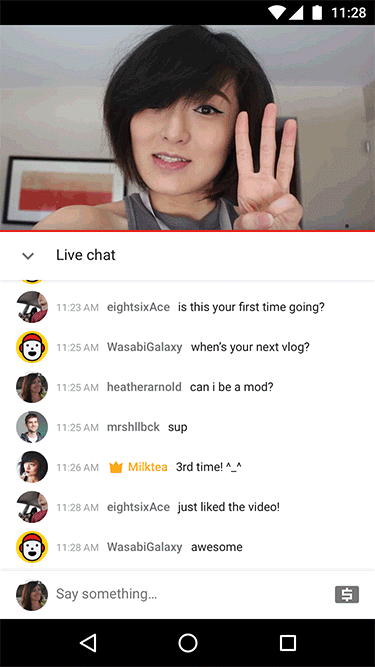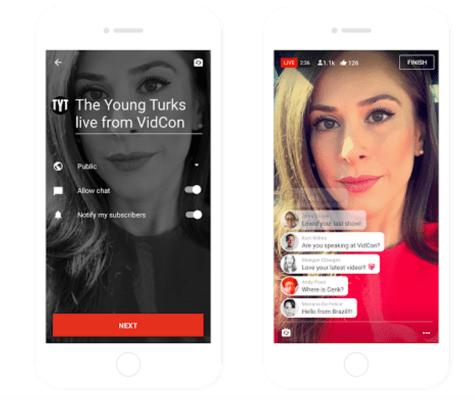Google’s video powerhouse YouTube is today taking its latest step to compete with Facebook Live and Twitter’s Periscope to be the go-to platform for live video streaming, specifically of the unscripted, on-the-fly kind.
YouTube today is turning on live video recording directly from its mobile app for creators who have at least 10,000 subscribers. And on top of this it’s taking Super Chat — a service where viewers can pay to bump up their comments in the stream — out of beta. Now, live video creators with over 1,000 subscribers in 20 countries can turn it on, and viewers from 40 can pay to promote their pearls of wisdom.
The opening up of YouTube mobile live streaming comes about six months after Google first turned on the feature for a select number of users (such as Lewis of Unbox Therapy and athlete-turned-YouTuber Ben Brown). In a blog post, product managers Barbara Macdonald and Kurt Wilms write that the feature will soon be rolled out even more widely, beyond the 10,000 follower mark set today.
As with the more limited roll out, the live streaming feature is built into the app, where you will be able to snap a cover picture, and then press another button to start recording. Once the live video is over, YouTube visitors will be able to discover them just like they would any other video (and you the creator can also set up privacy features as you would for any other video).
One thing that’s different with the version of live streams on mobile going live today is that YouTube will slow down live chat. “It turns out receiving 2,000 messages per second is a little too fast!” Macdonald and Wilms write. They also note that they’ve also worked on improving streaming quality across a wider range of devices.
YouTube likes to remind us that it has been a notable platform for people to watch live streams since 2011, with events like Felix Baumgartner’s record-breaking skydive in 2012 attracting 8 million live viewers on the platform; and more recently, the U.S. elections seeing millions come to YouTube to watch debates and other events as they unfold.
The difference here is the emphasis on videos recorded by YouTubers and everyday people with mobile devices, an area where YouTube has been slow to move.
Instead, services like Facebook’s Live and Periscope (and the now-defunct Meerkat) were quicker to tap into the confluence of faster mobile networks, better devices, and willing audiences of viewers and creators that have a taste for improvised video, to create content that has set a standard for live, unscripted streams.
(It’s notable too that Facebook launched its Live product as a mobile app-first effort in 2015 (the same year that Periscope also emerged) and only turned on a web-originated version last month.)
However, the significance of YouTube finally making a move to expand live vide streams on mobile is that it’s far and away the world’s biggest platform for online video today, with over 1 billion users (nearly one-third of all internet users) visiting at least once a day.
And the fact that more than half of those visits are on mobile means that there is a ready and willing audience of creators and consumers for live streams made on mobile.
While broadcast TV has died a little in the age of on-demand content, it’s services like this, created on platforms the size of YouTube, that have a shot of resuscitating live video popularity for today’s consumers and creators.
 …and, it might be added, advertisers. YouTube — like Facebook — has been playing with a lot of different formats for how best to monetize video — from autoplaying videos interspersed with ads to adding “midroll” ads during a single video” on its platform — and today marks a wider launch of another revenue-generating feature.
…and, it might be added, advertisers. YouTube — like Facebook — has been playing with a lot of different formats for how best to monetize video — from autoplaying videos interspersed with ads to adding “midroll” ads during a single video” on its platform — and today marks a wider launch of another revenue-generating feature.
Creators making live videos on desktop or mobile can now turn on Super Chat for comments. Launched in a beta version last month, Super Chat will let viewers pay some money to boost their comments and pin them to the top of the pile for some time — the degree of the boost and pin will depend on how much a commenter is willing to pay. (It’s not unlike the Cheering feature that launched on Twitch last year.) Creators will be responsible for moderating their own Super Chats, as they do their live chats, YouTube notes.
It also looks like YouTube splits revenues for Super Chat in the same way that it does for AdSense, as you can track your revenues from them in the AdSense dashboard.
Perhaps one of the most interesting things about Super Chat is that it lays the groundwork for paying for a whole lot of other things during live streams, and also helps motivate creators to make more of these live streams as part of their bigger business efforts.
